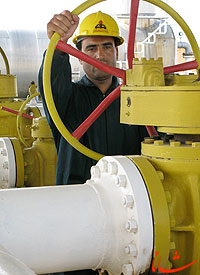National Iranian Gas Company (NIOC) Directorate of Production Coordination and Supervision is tasked with coordinating and supervising the affairs of gas refining companies. A total of seven gas refining companies are operating across the country under the authority of this Directorate. The companies receive gas from sources to be refined and fed into trunklines in order to finally reach end-users.
The Shahid Hasheminejad gas refinery (Khangiran) in Sarakhs in Iran’s northeastern most spot, the Ilam gas refinery in western Iran, the Bid Boland gas refining company (the oldest gas refinery in the Middle East), The Sarkhoun and Qeshm refinery in Bandar Abbas, the Parsian gas refinery in Fars Province, the Fajr Jam gas refinery in Bushehr Province and the South Pars Gas Complex (charged with gas recovery from the giant South Pars gas field) are currently processing and refining gas across the country.
Masoud Zardouyan, director of NIGC production coordination and supervision, said: “The gas refineries’ output totals 1 bcm/d.”
He said that in addition to treated gas, a variety of byproducts including condensate, sulfur, ethane, propane and butane were being supplied at the refineries.
He said that the current culture of high gas consumption needed to be modified, adding that gas, a God-given blessing, would have to serve the long-term interests of people and future generations.
13 Refineries at South Pars
Zardouyan touched on Iran’s gas production capacity, saying that 10 gas refineries had become operational in the offshore South Pars gas field area. He said that two more refineries had already become operational, but would be completely delivered to NIGC later on.
He said that Pars Oil and Gas Company (POGC) would also hand over a 13th refinery at South Pars by 2021, which would bring the total number of gas refineries to 13.
Gas Quality Closely Watched
Zardouyan said that refining companies were complying with NIGC’s IGS standard in their production. He said IGC was a strict environmental standard.
He said all requirements for IGC had been fulfilled at refining companies whose production is under close watch.
As far as byproducts are concerned, the standards are regulated based on the customers and buyers’ demands, while the sulfur content and the purity of products comply with standard levels.
The expression of satisfaction by foreign buyers of products with the high quality of products shows the high level of standards in gas production.
Ilam Refinery Development
Zardouyan said Ilam gas refinery was a strategic facility in Iran due to its location. He said that Ilam refinery’s role in gas supply to western Iran was similar to the Khangiran refinery’s gas supply to northeast Iran.
He said that the gas production spots were located in the southern half the country.
“In our view, the Khangiran storage facility (supplier of gas to the Hasheminejad refinery) in northeast and the Tange Bijar facility (supplier of gas to Ilam gas refinery) in the west are significant sources of gas supply,” the official said.
He added that National Iranian Oil Company (NIOC) had in its primary studies estimated that 10.2 mcm/d of gas would be recovered from Ilam refinery. In phase one, the output was 6.8 mcm/d, he said, adding that gas recovery has been under way at this refinery since 2007.
The second development phase of Ilam gas refinery is put out to tender, which would bring the final production capacity there at 10.2 mcm/d.
Flaring on the Decline
Zardouyan touched on the measures taken to reduce flaring at gas refineries across the country, saying: “The top priority in flaring is environmental concerns, including CO2 and SO2 emissions. The second point is the non-profitability of some varieties of gas that is flared. This issue takes up added significance in South Pars due to the concentration of more production units.”
Efficient Use
Asked about future production from mature reservoirs, Zardouyan said: “The accelerated development of South Pars in recent years has added to the country’s gas production on a daily basis. But the fact is that gas consumption has been increasing at the same pace. Once SP14 is completed development of South Pars would be over and no new development project could be envisaged to meet growing consumption. Therefore, we had better change habits and some uneconomical methods in order to benefit from this national asset in a better way in favor of public, society and future generations.”
Alternative Reservoirs
Zardouyan said gas reservoirs would deplete one day and gas refineries would be out of service.
He said that the Directorate of Corporate Planning at the Petroleum Ministry, NIOC and NIGC were holding regular meetings in order to find alternative gas reservoirs.
Courtesy of Iran Petroleum


Your Comment